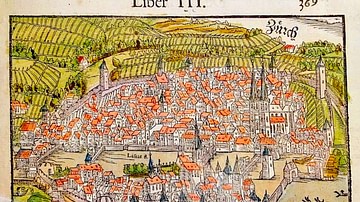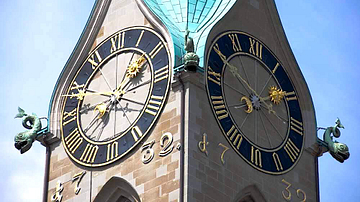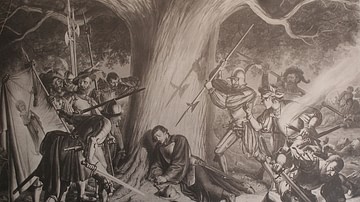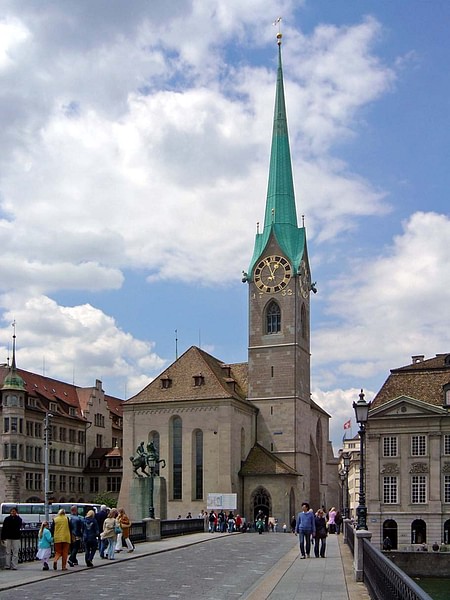
Fraumünster Church (“Women's church” in German) is a former Benedictine abbey situated in the heart of Zürich, Switzerland that was founded in the mid-9th century CE by Louis the German and his daughters, Hildegard and Bertha. Flourishing in the Middle Ages until the Swiss Reformation, Fraumünster had “imperial immediacy,” which gave the abbey a privileged political and constitutional status under imperial feudal law. The abbesses of Fraumünster were thus able to act and rule with tremendous power, independent of everyone except the Holy Roman Emperor himself. Following the Swiss Reformation led by Ulrich Zwingli, the abbey at Fraumünster was dissolved in 1524 CE and its last abbess, Katharina von Zimmern, placed Fraumünster in the control of the city of Zürich. Fraumünster has been a Swiss Reformed city church since that time. The church is one of the city's most recognizable landmarks and along with Grossmunster, Predigerkirche, and St. Peterskirche, Fraumünster is one of the oldest and largest churches in Zürich.
Legends & Medieval History
Situated on the west bank of the Limmat River some 180 m (551 ft) across from Grossmünster Cathedral, the Fraumünster Church was founded in 853 CE by Louis the German (r. 843-876 CE). According to legend, Louis' two pious daughters, Princess Hildegard (828-856 CE) and Princess Bertha (d. 877 CE), used to live nearby Zürich at Baldern Castle, and they frequently visited the city to worship before the relics of Saints Felix, Regula, and Exuperantius at Grossmünster Cathedral. One early morning, as the royal sisters made their daily visit to Grossmünster, they saw a white stag with burning antlers in the middle of the dark forest. The two women followed the stag, which took them to the edge of the Limmat River directly across from Grossmünster Cathedral. This encounter would repeat itself each morning until the sisters understood that God had given them a sign and had intended them to oversee a religious sanctuary for women at the edge of the river. King Louis was not entirely convinced by his daughters' stories until a rope fell from the heavens to mark the exact spot of where construction should commence. King Louis, Hildegard, and Betha thus oversaw the construction of Fraumünster Church, and the female duo became the first abbesses at the abbey.
In the Early and High Middle Ages, the abbesses of Fraumünster administered the convent where many noblewomen from southern Germany, Switzerland, and Austria took their religious vows. These abbesses, however, wielded immense power through the 14th century CE. From the 10th century CE onwards, they enacted rules and procedures regarding the customs on goods entering Zürich, appointed city mayors, acted as judges in trials, organized trade fairs, and minted their own coinage. From the 13th century CE, the abbess was even given the title of “imperial princess.” The incumbent abbess of Fraumünster was consequently the de facto ruler of the city of Zürich during most of the Middle Ages. Notable abbesses included Mechthild of Tyrol (r. 1145-1170 CE), Judith of Hagenbuch (1229-1254 CE), Mechthild of Wunnenberg (1255-1269 CE), and Elisabeth of Wetzikon (1270-1298 CE). It was only in the 14th century CE that Zürich's guilds begin to regain political and economic privileges back from the Abbess of Fraumünster through the establishment of guild laws (“Zunftordnung” in German) at the command of Rudolf Brun (c. 1290-1360 CE), Zürich's first independent mayor.

Although Brun managed to limit the influence exercised in Zürich's urban affairs by the abbesses of Fraumünster, the abbesses and Fraumünster Church remained quite influential until the 16th century CE. Zürich emerged as an important pilgrimage center during the high and late Middle Ages as the Catholic faithful visited the relics of St. Felix, St. Regula, and St. Exuperantius while en route to other pilgrimage centers like Santiago de Compostela in Spain, the Vatican in Rome, Italy, and the Benedictine Abbey in Einsiedeln, Switzerland, which lies only 40 km (25 miles) to Zürich's southeast. Although Fraumünster was engaged in a perpetual rivalry with neighboring Grossmünster for control over the relics of the city's three patron saints, the two churches shared and publically showcased these relics in an elaborate urban procession held annually on September 11th. (That day is the feast day of the three saints; this day is still celebrated as a holiday in the city of Zürich.) The two churches also grew incredibly wealthy through the offerings donated by pilgrims from across Europe.
Protestant Reformation & Modern Era
In 1519 CE, Ulrich Zwingli (1484-1531 CE) arrived in Zürich to begin his new work as pastor at Grossmünster Cathedral. Though born into a family of farmers, Zwingli was an educated man who completed his studies at the University of Vienna and University of Basel. The ideas of the Dutch philosopher Erasmus (1466-1536 CE) strongly influenced Zwingli, who shared Erasmus' belief that scripture should be read and preached liberally in one's native language as opposed to Latin. Zwingli quickly broke with established Catholic tradition soon after his arrival in Zürich, preaching a new, radical interpretation of the Gospels. Zwingli, with governmental approval and cooperation, dissolved Zürich's monasteries and confiscated the possessions belonging to Zürich's various churches and monasteries over the course of 1523-1524 CE.
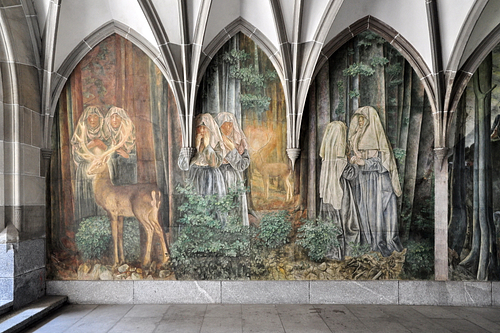
Curiously, Zwingli knew Fraumünster's last abbess from childhood: Katharina von Zimmern (1478-1547 CE). She had been a wise abbess who was praised for her learning and skillful management of the abbey's finances. Von Zimmern (r. 1496-1524 CE) did not oppose Zwingli's Reformation and shrewdly passed control of Fraumünster to the city of Zürich in late 1524 CE. She would remain a key figure in Zürich's political and social affairs until her death, but Fraumünster would become a Protestant church forever losing its former independent status. Like the other churches, abbeys, and monasteries in the Canton of Zürich, Fraumünster was physically affected by Zwingli's reforming zeal. The current austere simplicity of Fraumünster's interiors is a direct result of Zwingli's Reformation. In 1524 and 1525 CE, reformers removed Fraumünster's altars, organ, and all religious ornaments. Decorated walls and ceilings were whitewashed, and Fraumünster's stained glass windows were removed. The church's gable above the choir was removed as well, and Fraumünster's roof was altered into the hipped roof that visitors can see today.
Art & Architecture
Before the construction of Fraumünster, Celtic and Roman structures existed on the site now occupied by the church. Unlike nearby Grossmünster, Fraumünster has seen substantial changes in its design and structure since the first construction of the church in the 9th century CE. In comparison to Grossmünster Cathedral, Fraumünster reflects more of a hybridization of Romanesque and Gothic styles due to constant construction and remodeling over the centuries. During the 11th century CE, a large altar room with a choir apse was built, which provided Fraumünster with a traditional cross-shaped layout. The 9th-century CE crypt beneath the new choir was remodelled and a Romanesque cloister was built on the church's southern side during the 12th century CE. Fraumünster was completely remodelled in stages during the 13th century CE, and the altar room was enlarged to its maximum extent. While important medieval structures have been kept in place - the Romanesque choir and the high vaulted transept - Fraumünster's south tower was entirely removed in the 18th century CE. Parts of the convent complex, including old residential buildings for the canonesses, were destroyed in 1898 CE. Conservationists renovated Fraumünster's nave in 1911 CE, strengthening the church's north tower as a result of the removal of the south tower over a century earlier.
Fraumünster is renowned for the modern art and other curiosities found within its doors. Several frescoes by the Swiss artist Paul Bodmer (1886-1983 CE) illustrate the legend of the founding of Fraumünster by Princesses Hildegard and Bertha, as well as portraits of Zürich's patron saints Felix and Regula. August Giacometti (1887-1947 CE) - uncle to the equally famous Swiss artist Alberto Giacometti (1901-1966 CE) - designed the stained glass window in Fraumünster's north transept in 1945 CE. Marc Chagall (1887-1985 CE) worked at Fraumünster too, and he designed five stained glass windows in the 1970s CE in addition to Fraumünster's beautiful rosette, which is located in the church's south transept. Fraumünster's organ with 5,793 pipes is the largest in existence in the Canton of Zürich.


